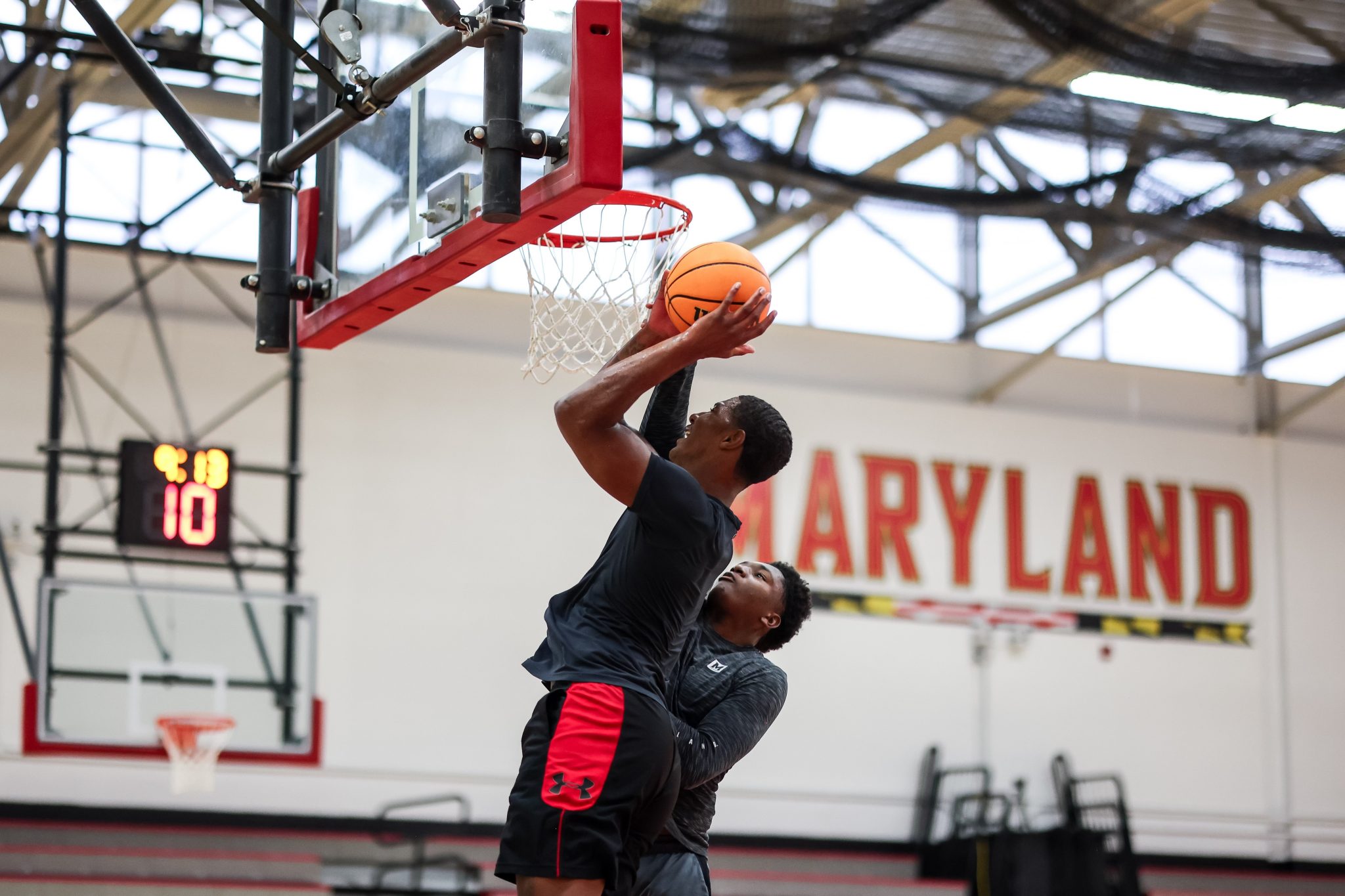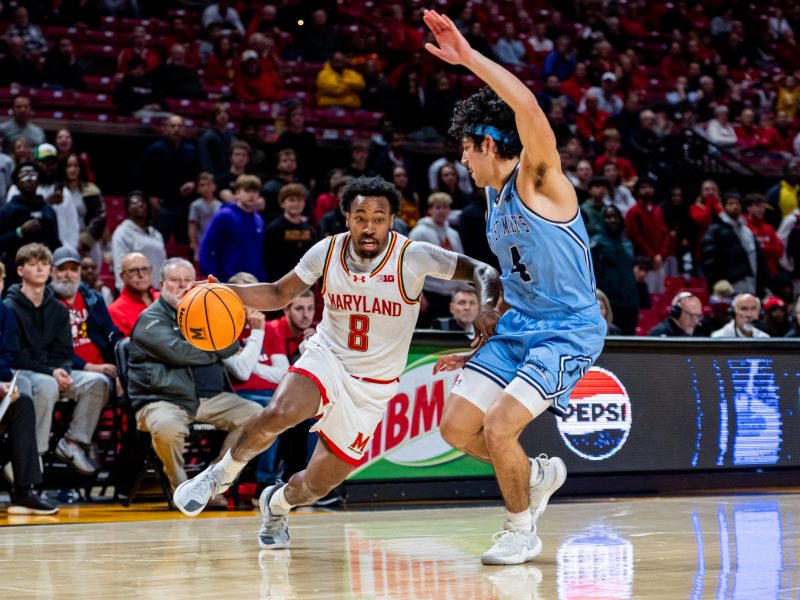As Julian Reese weighed his options in March — deciding between a return to College Park for his senior year or to transfer after a wildly disappointing season for Maryland men’s basketball — the prospective reunion with high school teammate Derik Queen helped Reese make an easy decision.
“[We were] really dominant,” Reese said. “Just thinking of that, and working to that, and we weren’t even the players we are today. It’s just mind-blowing. I’m excited to see what we can do.”
He first met Queen in middle school, describing him as a “cool, goofy kid.” They teamed up at St. Frances Academy in Baltimore when Reese was a high school senior and Queen was a freshman, whose five-star prowess showed even in his youth.
Four years later, they once again don the same jersey. Much has changed since they were last teammates, and replicating their success in the Big Ten is certainly a taller task.
Some question their fit together as two big men, but the talent of the high-pedigree Baltimore duo is evident. If all works out, they could fuel a bounceback year for the Terps and change the trajectory of coach Kevin Willard’s program.
The duo went undefeated in a COVID-shortened regular season at St. Frances. The Panthers suffered their only loss of the year in the Baltimore Catholic League championship game, finishing the year 15-1.
[Last offseason’s failures doomed Maryland men’s basketball. This cycle may shape its future.]
Reese and Queen, who stand at 6-foot-9 and 6-foot-10 respectively, both made all-conference teams. Queen, the No. 12 recruit in 247Sports’ 2024 composite rankings, was the MaxPreps National Freshman of the Year in 2021.
“It was fun. In practice we always used to go at it and then we won a lot of games with each other,” Queen said. “That was always my guy, we always hung out.”
The mild-mannered Reese and extroverted Queen got along and complemented each others’ skill sets, St. Frances coach Nicholas Myles said.
Myles said they could both “really shoot the ball” — an ability that’s seemingly faded over time. Neither made a three-pointer at their respective teams last year.
While the buzz of the offseason is that Queen’s shot looks more like it did back then, having two bigs who are unproven shooters leaves Maryland in limbo.
Derik Queen’s skill level for his size is ridiculous. Taking and making 3’s. An effortless offensive player.
— Jon Rothstein (@JonRothstein) July 17, 2024
“We’re just gonna make it work,” Queen said. “We both can guard, it doesn’t matter about that. What really matters is about spacing.”
Reese and Queen are always on opposing teams in practice and haven’t talked with Willard much about the details of them on the court together, but they aren’t concerned about sharing the floor come November.
Willard said he only plans to play them together for 12 to 15 minutes a game while surrounding them with shooters, nearly all of which come from the transfer portal.
The Terps had the third-worst three-point percentage among all power conference teams last year and lost their top three leaders in three-pointers made.
Transfers Ja’Kobi Gillespie and Selton Miguel are coming off efficient, high-volume seasons beyond the arc at the mid-major level last year. Rodney Rice, who sat out last season after an injury-riddled freshman year at Virginia Tech, entered college as a touted shooter.
[Maryland commit Derik Queen flashed star potential in McDonald’s All-American game]
“Say I’m posting up, it’s going to be pretty hard for them to double-team with a guy like [Queen] on the court, and more shooters around on the court, and the pieces that we got coming in,” Reese said.
Reese said he thinks Queen’s addition could put him on the perimeter more defensively, but defending the paint was arguably Reese’s biggest asset last year. Maryland allowed opponents to shoot just 33.3 percent in the paint, putting the Terps in the 98th percentile.
The Terps’ defensive rating was 13.5 points better with Reese on the court, a difference that also puts Reese in the 98th percentile, according to CBB Analytics. He finished the season as the fourth-best defender in the Big Ten, according to EvanMiya’s Defensive Bayesian Performance Rating.
“I really don’t care where I play at, but I feel like at the next level, I’ll probably have to make that transition to the four predominantly,” Reese said. “But I feel like right now in college, this game is really positionless.”
Despite Reese’s effectiveness protecting the rim, Myles sees Reese as more of a four defensively than Queen.
He views Queen as an offensive four, which could let him face up more and be on the perimeter. It’d allow Queen to serve as a hub for the offense and show off his passing chops and feel, which along with his pace, led Myles to compare him to three-time NBA MVP Nikola Jokić.
Even with some uncertainties, there are just as many reasons Terps fans should be excited.
The Terps’ top returning player will pair up with a former teammate who is Maryland’s second-highest rated commit in the modern recruiting era giving them a frontcourt tandem that many will compare to the Bruno Fernando, Jalen Smith duo.
Reese and Queen’s combination of size and skill figures to be a tough match-up for most opponents.
“Many teams in the league don’t have a one-two punch like that,” Reese said.
Baltimore basketball has some similar traits to the Big Ten, with physicality, toughness and grit being trademarked characteristics of both.
Queen and Reese will have a tougher time destroying their conference foes in college. But if they look anything like they did four years ago, last year’s disastrous campaign will be far in the rearview mirror.



